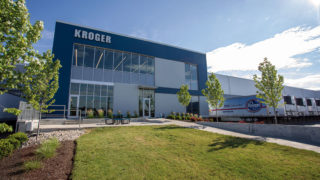Recent Articles
A “fresh” approach to warehouse design
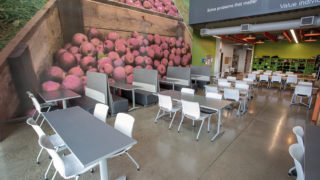
by Jeremy Klysen, PE, and Russell Schertz, market sector leaders for LEO A DALY’s food, distribution and manufacturing group
Attracting and retaining employees, adapting to a rapidly changing market, and distributing fresh, healthy foods are top-of-mind for our industrial clients. A fresh approach to warehouse design that values workers and thinks outside the box on site selection is critical to staying competitive.
Making employees feel valued
Design can do a lot to make a warehouse a more pleasant place to work, and in the process, build good-will among employees.
Kroger, the largest supermarket chain in the U.S., recently collaborated with LEO A DALY in the renovation of an existing 390,000-SF distribution center into what is now their Cincinnati Fresh Center. The renovation included the modernization of approximately 217,000 SF of existing dry grocery storage, truck maintenance space, office, employee break area, and dock, as well as an upgrade to 150,000 SF of perishable cooler space and the addition of a 45,000 SF freezer.
Beyond being state-of-the-art, energy-efficient, and food-safety focused, the main design goal was to creating a more engaging work environment through workplace-design strategy. The approach focused on increasing brand identity through a fresh and vibrant interior design, emphasizing key employee amenities and increasing pride-of-place.
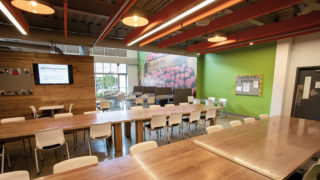
To appeal to a new generation of employees, the team started by completely rethinking the employee experience. Cincinnati Fresh Center is much more open than a typical distribution center, creating a lot of visibility between areas, and allowing freedom of movement for all employees. This is a big shift from typical distribution centers, which limit where drivers, packers, and administrators can access through passive and active security measures. The design works because it highlights Kroger’s transparent corporate culture.
Employees today want to belong to a mission-driven organization, and we wanted to capture that mission in the design. The interiors create an uplifting work environment where people feel like they’re contributing to something bigger than themselves. The interior finishes are colorful and vibrant, with references to Kroger’s mission to “feed the human spirit.”
We’ve heard from Kroger that the design is having its intended effect, and that morale is high in their Cincinnati Fresh Center. In a recent internal survey of Kroger employees on trust and communication, they found that the Cincinnati Fresh Center ranked in the top 25 percent of their facilities, right alongside their retail stores and offices. For a distribution center, that’s pretty incredible.
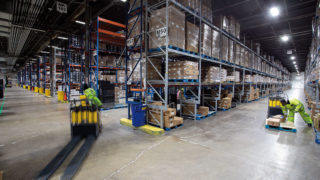
Cold comfort
Warehouses can be harsh environments to work in. When they’re cold, they’re really cold. When they’re unrefrigerated, they respond directly to the ambient temperature, which in certain times of year can be brutal. An investment in thermal comfort can pay dividends when it comes to employee retention.
A few years ago, Dollar General asked LEO A DALY to help them rethink the design of their distribution centers. Like Kroger, a key goal was improving employee retention. One of our big innovations was to use industrial refrigeration to air-condition their dry storage areas.
Low-charge ammonia systems are sustainable, cost-effective means of cooling refrigerated warehouses, but they’re not typically used for regular air conditioning. For Dollar General, we broke the mold, using ammonia refrigeration to keep a million-square-foot dry storage area comfortable for employees. Normally this would be extremely inefficient, but innovative thinking by our refrigeration engineers made it possible.
The results have been great for employee retention. What started with one prototype facility in Bessemer, Alabama, has been so successful that Dollar General has gone back to it seven times. They are currently building a new, one-million square-foot distribution center in Longview, Texas, using the same prototype design.
Cold-storage areas have the opposite problem. In designing them, we find other ways to keep employees comfortable. Spot heaters allow for a quick warm-up, and added attention to break areas give them an opportunity to fully thaw and recharge between trips into the freezer.
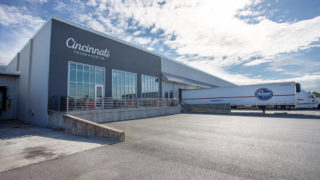
Fast, fresh fulfillment
Growing demand for fast, fresh foods is changing how we approach site-selection and facility design.
The trend toward fresh-cut fruit and vegetables, ready-to-eat meals, and ready-to-cook meal kits has motivated grocers to move commissary production out of stores and into custom facilities. So, instead of making subs or chicken-salad in the deli department, they’re made in small, off-site facilities that deliver the product fresh to stores daily. This allows grocers to be more efficient and turn out larger volumes, while still getting fresh products to the shelves fast.
The result has been a range of new construction and renovation projects, from new cut centers, to retrofits of existing properties, to food-processing facilities being added onto to existing distribution centers.
Meanwhile, e-commerce has evolved from being perceived as a threat to brick-and-mortar, to being a complement. Grocers now have robust e-commerce departments, and view online shopping as just another business line. This has resulted in a shift from distribution centers located away from urban centers, to fulfillment centers built much closer to consumers.
These trends have fundamentally changed how we evaluate sites for our clients. Proximity to customers is a top priority, so we have to be flexible and creative about where we look and what we consider. That dead shopping mall is now in play. So is the shuttered retail space on the strip mall, and the garage by the railroad tracks. Small and close to consumers is the key when looking to site a last-mile fulfillment or assembly center.
